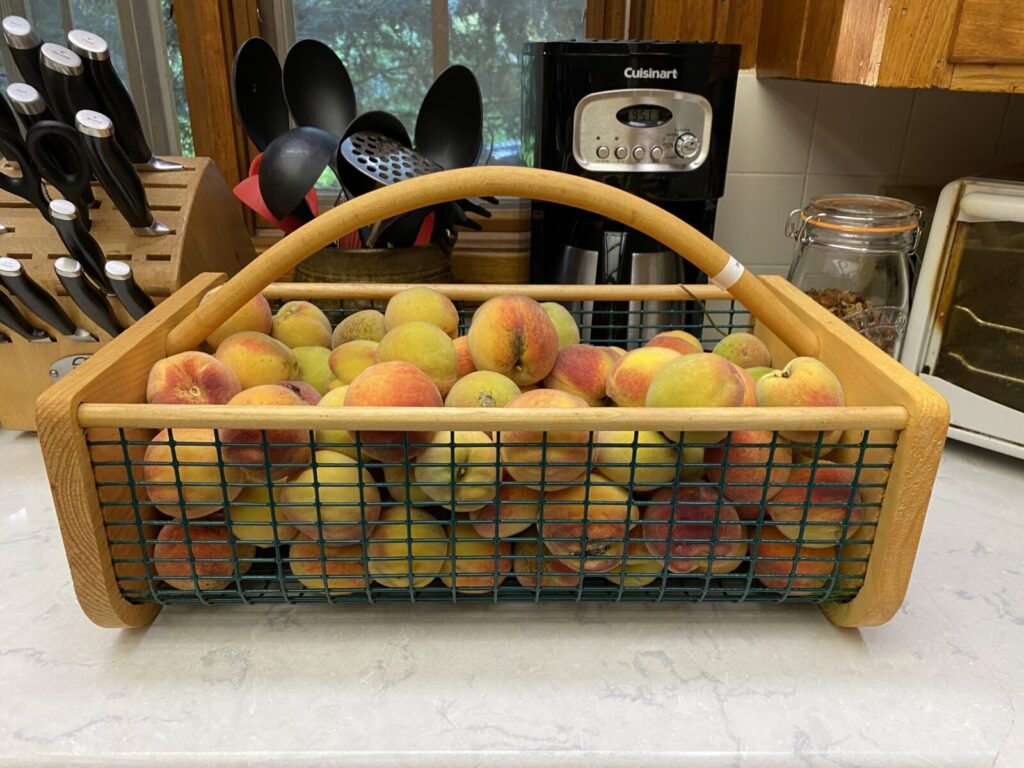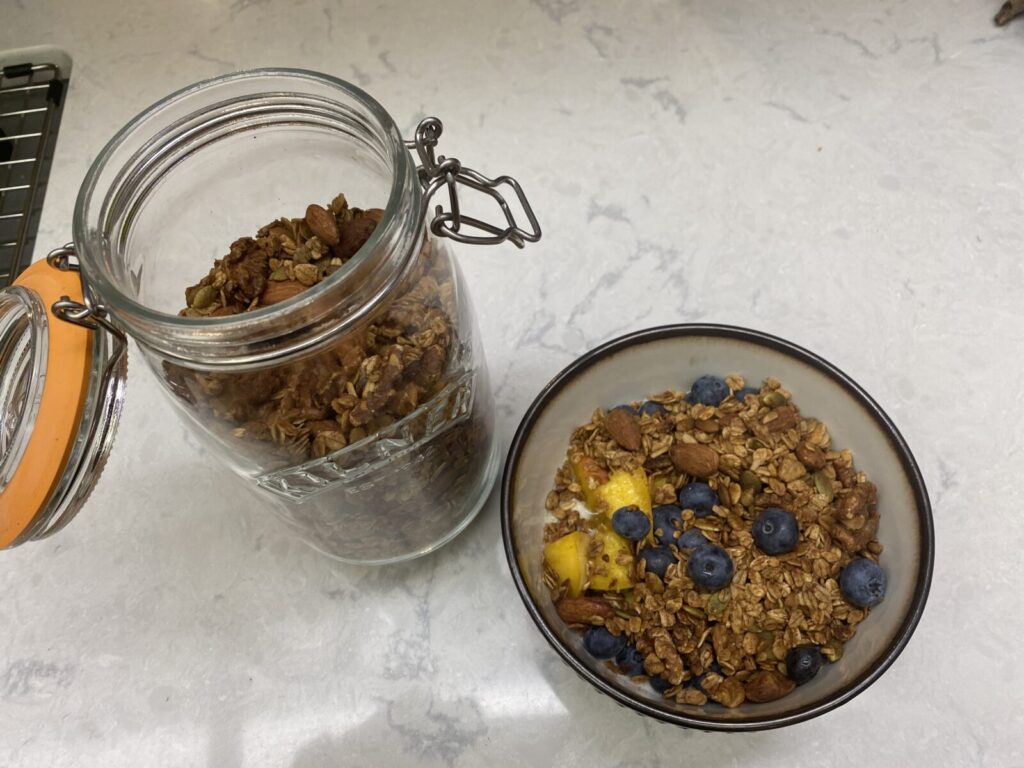Plus, Maple Cinnamon Granola
The food of summer never fails to lift my spirits. I don’t always love the summer heat and humidity, or the constant craziness of parties, festivals and get-togethers, but I am never disappointed by the sights, smells and flavors of each new fruit or veggie at its peak.
I am an avid farmers’ market shopper. Every Saturday morning, I roll my family out of bed to head for our favorite market, the East Aurora Farmers’ Market. It’s a producer’s market, which means vendors have to grow or otherwise produce what they sell. There’s no bananas or oranges here, just the seasonal produce of Western New York, along with local flowers, honey, maple syrup, cheeses, meats and more.
If I had to choose a favorite fruit, it would probably be blueberries, with peaches a close second. Strawberries show up as the first fruit of summer, followed by raspberries and cherries, but they’re all fleeting, lasting only a couple of weeks. Blueberries roll in around July 4 and stick around through Labor Day, so I appreciate their persistence as well as their ease of preparation (basically, none).
Blueberries have long been called a “superfood” due to their powerful antioxidant activities. According to Cornell University, blueberries rank number one in antioxidant activity when compared to 40 other fresh fruits and vegetables. The pigments that make blueberries blue (called anthocyanins) are the major driver in their antioxidant power. Antioxidants help our bodies neutralize “free radicals,” natural by-products of the process of turning food into energy. We also produce free radicals during exercise and encounter them in our environment through exposure to cigarette smoke, air pollution and other toxins. Free radicals steal electrons from other substances, causing changes in our bodies’ DNA, cell membranes and other structures. Free radicals, when left unchecked, can also cause a condition called oxidative stress, which can damage cells and lead to chronic disease. Antioxidants work by “donating” electrons to free radicals, without becoming damaged themselves.
Antioxidants do great things, so taking huge amounts of them in supplement form must be even more helpful, right? Not necessarily. While antioxidants are beneficial, they are only part of the package that makes fruits and vegetables so good for us. To get the full array of benefits, you need to eat the whole fruit or vegetable, not just one isolated substance. Antioxidants work best when consumed in small amounts, in combination with other substances found in plant foods. This is why eating a diet rich in a variety of fruits, vegetables and whole grains is superior to taking a variety of supplements. Supplements are a clunky replacement for the vast network of vitamins, minerals, fiber and micronutrients that make up whole foods.
Back to blueberries. Summer blueberries are so wildly superior to grocery store blueberries that it’s not even worth the effort to compare them. My very favorite blueberries come from Childs’ Blueberries in Hinsdale. Their berries are massive and delicious, and in Childs’ own words, “beyond organic.” They use Integrated Pest Management (IPM) to manage their crop – many years, this means using no sprays at all.
In peak season, Childs’ sells huge baskets of blueberries, which we freeze and enjoy all winter long in oatmeal, muffins, pancakes and yogurt. My son (who will, going forward, be referred to as “The Child”) loves to eat them frozen, straight out of the bag.
In 2019, we moved to be closer to friends and the city and found a beautiful Arts and Crafts style home on an acre and a half. The property came with 10 or 12 fruit trees that we jokingly refer to as “the orchard.” Most of the trees are apple; there’s a few pear, plum and cherry trees also. Two of the trees are peach trees, and the first summer we lived in the house, we harvested four peaches from the trees. Not four quarts or four bushels, but four peaches. We laughed and ate them, and thought it was cute to have a few “homegrown” peaches. The second year, we had a late freeze in the spring and had no fruit at all from the orchard.
2021? See for yourself.

We filled that basket with peaches FOUR TIMES this summer. We gave peaches to everyone we knew, twice. I made peach cobbler, peach crisp and peach galette. I froze two peach pies and four gallon-size freezer bags of sliced peaches.
So. Many. Peaches. I love peaches – the fuzzy skin, the way freestone peaches separate neatly into their two halves, the drip-down-your-arm juicy goodness of a perfect peach. However – this was a lot of peaches, even for me!
I’m not sure there is a more perfect pairing of fruit than blueberries and peaches. My very favorite way to combine them is for breakfast with yogurt and homemade granola. Yogurt in our house is always plain yogurt and my granola recipe is adapted from Food to Live By: The Earthbound Farm Organic Cookbook by Myra Goodman, tweaked many times until I could make it in my sleep. Food to Live By is out of print now, I believe, but you might find it at your library or favorite used bookstore.

The original recipe calls for 1 ¼ cups of maple syrup. 1 ¼ cups is a lot of maple syrup. I am obsessive about cutting back on sugar in recipes and this one was no exception. I cut back more and more, and made many batches of granola, until I finally landed on ½ cup as the right amount to use. You must use REAL maple syrup in this recipe. No pancake syrup or maple-flavored syrup! Use the darkest syrup you can find. If you buy your syrup from a local producer, this will probably be NY Grade A Dark Color Robust Taste. In my experience, it’s very difficult to find NY Grade A Very Dark Color Strong Taste, but use it if you can find it. A stronger flavor allows you to use less syrup, but still have all the maple-y goodness.
The other ingredient that makes this granola so amazing is cinnamon, two tablespoons of it. Use a very high quality cinnamon here. I use Vietnamese cinnamon, purchased from my friend Milly Ferrer at Spices and Mixes by Milly.
This granola stores beautifully and is equally delicious eaten as cereal, with yogurt, or just by the handful. During the holidays, I make several batches and pop it into mason jars as gifts. Feel free to try different combinations of nuts and seeds, or add raisins or dried cranberries after cooling.
Maple Cinnamon Granola
Adapted from Food to Live By: The Earthbound Farm Organic Cookbook by Myra Goodman
4 ½ cups rolled oats
1 cup raw almonds
1 cup raw walnuts
¾ cup pumpkin seeds (pepitas)
½ cup real maple syrup (dark and robust)
¼ cup canola oil (or other neutral-flavored oil)
2 tablespoons ground cinnamon
Preheat oven to 325 degrees and grease or spray a large baking sheet. Combine all ingredients in a large mixing bowl and spread evenly onto greased baking sheet. Bake for 25 minutes. Stir granola carefully and return to oven for an additional 15 minutes. Remove from oven and let cool completely before eating or storing. If you like, add 1 cup dried fruit before storing and mix well.
Thanks for being with me on this wellness journey.


Leave a Reply